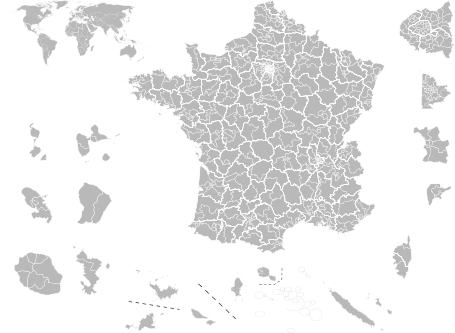French legislative election, 2017
| | |||||||||||||||||||||||||||||||||||||||||||||||||||||||||||||||||||||||||||||||
| |||||||||||||||||||||||||||||||||||||||||||||||||||||||||||||||||||||||||||||||
| |||||||||||||||||||||||||||||||||||||||||||||||||||||||||||||||||||||||||||||||
|
| |||||||||||||||||||||||||||||||||||||||||||||||||||||||||||||||||||||||||||||||
| Constituency results after the first and second round | |||||||||||||||||||||||||||||||||||||||||||||||||||||||||||||||||||||||||||||||
| |||||||||||||||||||||||||||||||||||||||||||||||||||||||||||||||||||||||||||||||
 |
| This article is part of a series on the politics and government of France |
|
Related topics |
| France portal |
Legislative elections are scheduled to take place on 11 and 18 June 2017 to elect the members of the 15th National Assembly of the French Fifth Republic.
Background
2012
The previous French legislative election was held on 10 June 2012, with a second round of voting on 17 June. The election was held shortly after the election of the Socialist François Hollande as President of France in the presidential elections of 21–22 April and 5–6 May that year. The legislative elections granted the left-wing parties a majority in the National Assembly, with 341 (59%) of the 577 seats going to the left, against 229 (40%) for the parties supporting the then-incumbent President Nicolas Sarkozy.[1] Hollande was sworn in on 15 May,[2] and subsequently formed a coalition cabinet consisting of the Socialists, the Radical Party of the Left, and The Greens. The cabinet was headed by Jean-Marc Ayrault until 31 March 2014.
2014
In early 2014, amid declining approval ratings for the Socialist administration,[3] and after the defeat of the left-wing parties in the 2014 local elections, Manuel Valls was chosen to replace Ayrault as Prime Minister of France; he took office on 31 March 2014.[4] Two months later, in May, elections were held for the European Parliament in all the EU members states, including France. Elections for the French delegation, consisting of 74 MEPs overall, took place on 24–25 May 2014. In the event, the National Front party of Marine Le Pen emerged victorious, taking close to 25% of the vote and 24 seats in the European Parliament. Meanwhile, the main opposition Union for a Popular Movement (now The Republicans) fell to 21% and 20 MEPs, while the Socialist Party slipped to 14% and 13 MEPs.[5]
In August 2014, President Hollande asked Manuel Valls to reshuffle his cabinet, leading to the formation of the Second Valls Government on 27 August.[6]
The Senate elections on 28 September handed a majority to the center-right UMP-led alliance, with Gérard Larcher subsequently becoming the President of the Senate.
2015
The offices of the satirical magazine Charlie Hebdo were attacked on 7 January 2015, by affiliates of the Yemeni Al-Qaeda branch Saïd and Chérif Kouachi, both French citizens born to Algerian immigrants. The attacks resulted in 12 deaths and a further 11 injuries. In the aftermath of the attack, the approval ratings of President François Hollande spiked, reaching 40% for the first time since February 2013.[7]
In elections held throughout 2015, namely the March departmental elections and the December regional elections, the Socialist Party suffered further setbacks.[8]
Electoral system
The 577 members of the National Assembly are elected from single-member constituencies using the two-round system. Citizens may field their candidacies in a district, and participate in the first round. If a single candidate obtains over 50% of the vote, as well as a minimum of 25% of all registered voters, they win. If no candidate meets these criteria, a second round is held in which the two most-voted candidates from the first round, plus any other candidate who obtained above 12.5%, are allowed to participate. Of the 577 constituencies, 539 are in Metropolitan France, 27 are in overseas departments and territories and 11 are for French citizens living abroad.[9]
Opinion polls
Voting intention
| Polling Firm | Last Date of Polling |
FG | PS | PRG | DVG | EELV | MoDem | UDI | DVD | UMP/ LR |
DLF | FN | Margin of Error |
Sample Size |
Lead |
|---|---|---|---|---|---|---|---|---|---|---|---|---|---|---|---|
| CSA | December 2, 2014 | 8 | 18 | 7 | 12 | 24 | 1 | 23 | 1 | ||||||
| Legislative Election | June 10, 2012 | 6.9 | 29.4 | 1.4 | 3.4 | 5.5 | 1.8 | 4.0 | 3.5 | 27.1 | 0.6 | 13.6 | 2.3 | ||
Seat projections
| Polling Firm | Last Date of Polling |
FG | PS | PRG | DVG | EELV | MoDem | UDI | DVD | UMP/ LR |
DLF | FN |
|---|---|---|---|---|---|---|---|---|---|---|---|---|
| Opinion Way | June, 2016 | 188–208 | 266–292 | 58–64 | ||||||||
| CSA | December 2, 2014 | 56–66 | 485–505 | 1–3 | 14–24 | |||||||
| Legislative Election | June 10, 2012 | 10 | 280 | 12 | 22 | 17 | 2 | 20 | 15 | 194 | 2 | 2 |
References
- ↑ http://www.nytimes.com/2012/06/18/world/europe/french-socialists-win-majority-in-parliament.html?_r=0
- ↑ Angelique Chrisafis in Paris. "François Hollande sworn in as president in low-key ceremony | World news". The Guardian. Retrieved 2016-08-04.
- ↑ Mail, Daily (2013-11-17). "Hollande rating falls even further: French President's approval score dips below 20% | Daily Mail Online". Dailymail.co.uk. Retrieved 2016-08-04.
- ↑ Samuel, Henry. "Manuel Valls, France's new prime minister: profile". Telegraph. Retrieved 2016-08-04.
- ↑ "Results of the 2014 European elections - Results by country - France - European Parliament". Europarl.europa.eu. Retrieved 2016-08-04.
- ↑ "RECAP: Hollande orders Valls to name new gov't - The Local". Thelocal.fr. 2014-08-25. Retrieved 2016-08-04.
- ↑ Alberto Nardelli. "Le rebound - Hollande's popularity rises 21 points in one month | News". The Guardian. Retrieved 2016-08-04.
- ↑ "Heavy losses in regional elections leave France's Socialists with tactical dilemma". France 24. Retrieved 2016-08-04.
- ↑ Electoral system IPU
.jpg)
.jpg)
.jpg)
.jpg)
.jpg)
